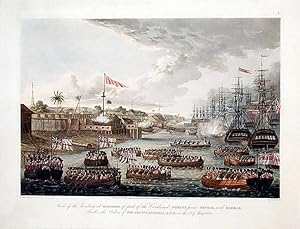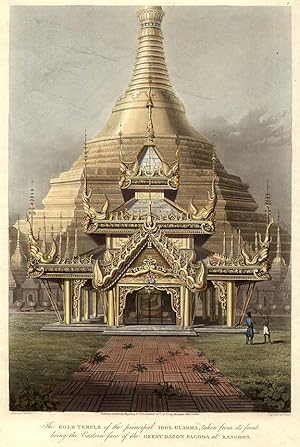Moore, Lieutenant Joseph, and Captain Frederick Marryat (2 results)
Product Type
- All Product Types
- Books
- Magazines & Periodicals
- Comics
- Sheet Music
- Art, Prints & Posters (2)
- Photographs
- Maps
-
Manuscripts &
Paper Collectibles
Condition
- All Conditions
- New
- Used
Binding
- All Bindings
- Hardcover
- Softcover
Collectible Attributes
- First Edition
- Signed
- Dust Jacket
- Seller-Supplied Images
- Not Printed On Demand
Seller Location
Seller Rating
-
View of the landing at Rangoon of part of the Combined forces from Bengal and Madras, under the Orders of Sir Archd. Campbell, K.C. B. on the 11th of May 1824
Published by Kingsbury & Co. and Thomas Clay, London, 1825
Seller: Donald A. Heald Rare Books (ABAA), New York, NY, U.S.A.
Art / Print / Poster Signed
Hand-coloured aquatint plate engraved by H. Pyall after Moore. In excellent condition. Image size: 10 x 14 5/8 inches. A beautiful plate from Moore's work "Eighteen Views taken at & Near Rangoon," an important visual record of the Burmese countryside and scenery, and of the war between the Burmese and British in 1824 to 1826. Following Burmese incursions into British held territory in 1821-1823 (including the successful invasion of Assam), the Governor-General, Lord Amherst, declared war on Burma on February 24, 1824. The British were successful in expelling the Burmese from Assam, but Bandula, the ablest of the Burmese generals, repelled a British detachment at Ramu on the Chittagong frontier. In reply, the British sent an expedition of 11,000 men under Major-General Archibald Campbell and ships under Captain Frederick Marryat to attack Rangoon by sea. The expedition resulted in the capture of Rangoon on May 11, 1824, with the Burmese forces fleeing into jungles of Pegu. Meanwhile, Bandula had been recalled and arrived in Rangoon on December 1 with 60,000 men. He was, however, defeated on December 15 and then retreated to Donabew, where, after a brave defence, he was killed in April 1825. On April 25, Campbell captured Prome, the capital of Lower Burma. The fighting continued sporadically throughout the rest of 1825 and into 1826, until a peace treaty was signed on February 24. Joseph Moore was a Lieutenant in the 89th Regiment. Frederick Marryat's involvement in the conflict began in March 1823 when he "commissioned the Larne for service in the East Indies, where he arrived in time to take an active part in the first Burmese war. From May to September 1824 he was senior naval officer at Rangoon, and was officially thanked for his able, gallant, and zealous co-operation with the troops. The very sickly state of the ship obliged him to go to Penang, but by the end of December he was back at Rangoon, and in February 1825 he had the naval command of an expedition up the Bassein River, which occupied Bassein and seized the Burmese magazines." (DNB) Abbey Travel II, 404; Tooley 334.
-
The Gold Temple of the principal Idol Guadma, taken from its front being the Eastern face of the Great Dagon Pagoda at Rangoon
Published by Kingsbury & Co. and Thomas Clay, London, 1825
Seller: Donald A. Heald Rare Books (ABAA), New York, NY, U.S.A.
Art / Print / Poster Signed
Hand-coloured aquatint plates engraved by G. Hunt after Moore. Very good condition apart from some light soiling. A beautiful plate from Moore's book "Eighteen Views taken at & Near Rangoon," an important visual record of the Burmese countryside and scenery, and of the war between the Burmese and British in 1824 to 1826. Following Burmese incursions into British held territory in 1821-1823 (including the successful invasion of Assam), the Governor-General, Lord Amherst, declared war on Burma on February 24, 1824. The British were successful in expelling the Burmese from Assam, but Bandula, the ablest of the Burmese generals, repelled a British detachment at Ramu on the Chittagong frontier. In reply, the British sent an expedition of 11,000 men under Major-General Archibald Campbell and ships under Captain Frederick Marryat to attack Rangoon by sea. The expedition resulted in the capture of Rangoon on May 11, 1824, with the Burmese forces fleeing into jungles of Pegu. Meanwhile, Bandula had been recalled and arrived in Rangoon on December 1 with 60,000 men. He was, however, defeated on December 15 and then retreated to Donabew, where, after a brave defence, he was killed in April 1825. On April 25, Campbell captured Prome, the capital of Lower Burma. The fighting continued sporadically throughout the rest of 1825 and into 1826, until a peace treaty was signed on February 24. Joseph Moore, a Lieutenant in the 89th Regiment, includes images that begin with the departure of Campbell's invasion force and conclude in July 1824. They are a finely balanced mixture of eye-witness battle scenes with a number of very fine views of the countryside and buildings in and around Rangoon. Frederick Marryat's involvement in the conflict began in March 1823 when he "commissioned the Larne for service in the East Indies, where he arrived in time to take an active part in the first Burmese war. From May to September 1824 he was senior naval officer at Rangoon, and was officially thanked for his able, gallant, and zealous co-operation with the troops. The very sickly state of the ship obliged him to go to Penang, but by the end of December he was back at Rangoon, and in February 1825 he had the naval command of an expedition up the Bassein River, which occupied Bassein and seized the Burmese magazines. [It was during this period that he made the sketches worked up into the plates in the second part of the present work]." (DNB) Abbey Travel II, 404; Tooley 334.



